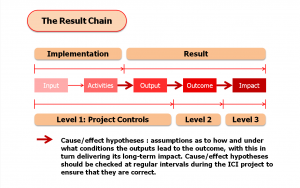Results-based Project Planning
Source: Guidance document, notes on ICI project proposals and monitoring
The Results-based Project Planning is based on the results chain as defined by the OECD. This assumes that the activities carried out by a project create products, goods, services or sets of regulations/standards (specific project goals) that are termed outputs in the Project.
These, in turn, are the prerequisite for achievement of the outcome (overarching project goal). The outcome (overarching project goal) describes a change at the level of the target groups that has been made possible by the project and can verifiably be attributed to it. The impact (long-term result) of the Project is the contribution made to mitigate climate change through emission reduction or adaptation to the consequences of climate change.
The results chain according to the OECD is shown in diagrammatic form below. The grey arrows represent the cause/effect hypotheses that link the various levels. Cause/effect hypotheses are assumptions as to how and under what conditions the outputs lead to the outcome (for example the target group’s use and application of the information material provided by a project), with this in turn delivering its long-term impact. Cause/effect hypotheses should be checked at regular intervals during the ICI project to ensure that they are correct.
The diagram also shows that the outputs2 and the outcome have to be specified by indicators.
The project can thus be divided into three levels:
Level 1 is the project’s direct intervention level, where the activities and outputs (specific project goals) are located. These are implemented/achieved by the project directly, and can therefore also be monitored.
The outcome (overarching project goal) is located on level 2. This level describes the effects of the project on its environment, in other words on partners, intermediaries and the target group. The outcome (overarching project goal) is therefore also achieved through the participation of target groups and intermediaries.
The project is not able to exercise complete control over the behaviour of intermediaries and target groups, and nor therefore the achievement of the outcome (overarching project goal). It can however prepare for the outcome (overarching project goal) and steer towards it.
Causal verification can also be provided that the outcome (overarching project goal) can be attributed to the activities and the outputs – meaning the products, goods, services and sets of regulations/standards produced by the project (specific project goals).
The impact (long-term result) is located on level 3. The contribution of the Project to the impact (long-term result) can be plausibly deduced. It can however not be assumed that the impact (long-term result) is brought about solely through the Project.












 lingkarLSM.com
lingkarLSM.com PENABULU ALLIANCE
PENABULU ALLIANCE KOMUNITAS KEUANGAN LSM
KOMUNITAS KEUANGAN LSM KYUTRI KELAS BERBAGI
KYUTRI KELAS BERBAGI RUMAH KEMUNING
RUMAH KEMUNING